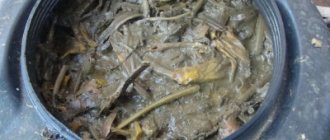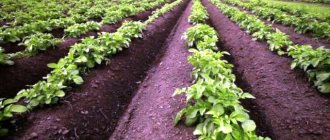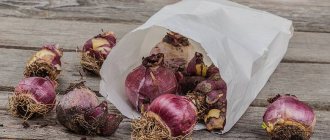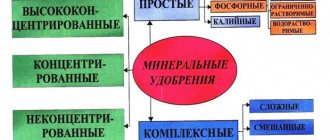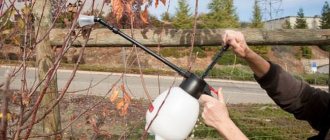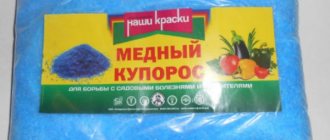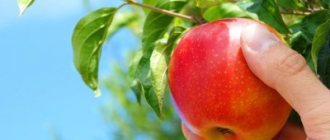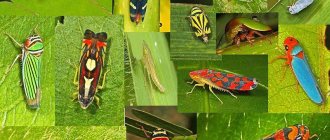Many people know that iron compounds are one of the most effective (and, importantly, inexpensive) means of combating mold and mildew, since almost everyone is involved in repairs, if not construction.
However, this is not the only area of application of copper and iron sulfate. Experienced summer residents prefer them to numerous store-bought fungicides. The advantage of these powders is that they are used more widely, and not just to eliminate damage to garden vegetation by rot, scab, moniliosis and a number of other diseases. They are no less effective as disinfectants, and are also often added to some types of soil as mineral fertilizer.
However, not everything is so simple. There are differences between iron and copper sulfate in some properties, specifics of use and a number of other parameters, which is quite understandable, given the differences in their chemical composition. This is what inexperienced summer residents overlook, believing that their scope of application in gardening is completely identical. Therefore, it is important to know which powder to use and for what purpose.
inkstone
Its blue crystals with a slightly greenish tint contain approximately 55% of the active substance.
Technical conditions for products - grade, chemical composition and a number of other features of iron sulfate or its sulfate (common names for this powder) - are described in detail in GOST No. 6981 of 1994. By the way, it is referred to as iron (II) sulfate heptahydrate.
Features of the product
- Compared to its copper “brother,” iron sulfate contains virtually no toxic components. However, its overdose is undesirable, as it causes a number of side effects. Therefore, when preparing various solutions based on it, the recommended proportion must be observed.
- Iron sulfate is not flammable. However, many sources emphasize that it is explosive. This fact dictates the need for particularly careful compliance with safety measures.
- The shelf life is unlimited, unlike most advertised expensive drugs. The only requirement is in a dry place and in an airtight seal.
As a rule, it is sold in bags of 200 and 250 g.
Safety precautions when working
Ferrous sulfate is not very dangerous for humans - it belongs to the third class of toxicity. This substance does not burn or ignite. But at the same time, when working with it, it is still necessary to observe safety measures: wear glasses and a respirator to protect the mucous membranes of the nose, mouth and eyes.
If it gets on your skin, nothing bad will happen - just wash the affected area with soap and water. In case of contact with the stomach, qualified medical assistance will be required.
The use of iron sulfate
Soil feeding
Iron is one of the most essential chemical elements for plants. By introducing it into the soil, you can increase crop yields, “reanimate” old or withering trees and shrubs, in a word, give a new impetus to the development of garden plantings.
When working on a site in autumn, it is recommended to add iron sulfate to organic fertilizers, which are scattered throughout the area before digging up the soil. This is especially important for fruits and berries, as well as a number of ornamental plants. For example, currants, grapes, gooseberries, roses. During the winter period, not without the help of melt water, the earth is saturated with iron to a sufficient depth. In this form, it is much easier for the root system of flora representatives to absorb it.
On a note!
The use of iron sulfate as a top dressing is a very delicate issue. The dosages indicated on the packages are approximate and are recommendations only. It is necessary to take into account not only the characteristics of the soil on the site, but also the type of vegetation and the appearance of this or that representative of the flora. Perhaps there is enough iron in the soil for it, and the reason for the faded foliage (poor yield, small fruits) is completely different. Therefore, consulting a specialist on this point will definitely not be superfluous. Especially if you take into account that the use of chemicals in the fall is extremely undesirable.
Pest extermination
A 5% solution destroys not only insects, but also their larvae and egg laying. Iron sulfate is recommended to be used both for spraying garden plants and as an additive to whitewash, which is used to treat trunks. Preferably both in autumn and early spring.
Unfortunately, not all sources indicate the specifics of preparing the whitewash composition. Mixing iron sulfate with lime, which is mainly used by summer residents, is undesirable. If you decide to use this particular powder for prevention, then you need to whiten trees and bush stems with a special means. It is often called garden paint. Not in short supply and inexpensive.
Control of plant diseases
Experienced gardeners use iron sulfate not only after the fact, that is, when identifying lesions, but primarily as a prophylactic agent. It is effective against black cancer, fruit (gray) rot, scab, and powdery mildew. And this is not a complete list of all the ailments that iron sulfate cures. It is also used to rid vegetation and garden areas of lichens and mosses.
Prevention (elimination) of chlorosis
This specific disease of garden crops is the result of a lack of iron elements in the soil. By adding this powder to it, the owner of the site restores the eco-balance, thereby increasing not only the productivity of plants, but also their immunity.
Disinfection of places of mechanical damage
Unfortunately, trees and shrubs are susceptible to them not only from careless handling of garden tools. For example, pruning, which is systematically carried out on the site. In addition, birds constantly search for insects on trunks and under the bark; strong gusts of wind breaking branches. Treatment of lesions with iron sulfate promotes rapid healing of wounds.
Surface treatment
Iron sulfate is an effective remedy used by gardeners to disinfect cellars, various mini-warehouses and storage facilities. Ceilings, walls and even floors are treated with its solution. This ensures that mold and mildew are unlikely to grow in this confined space.
Approximate dosages of iron sulfate
For those gardeners who did not buy it, but took it from someone, approximate data on the concentration of the powder may be useful (in %).
- Spraying, whitewashing – 8 – 10.
- Fight against black spot – 0.3.
- Prevention against scab, black cancer and a number of other diseases – 5.
- Treatment of walls and ceilings of storage rooms – 5 – 7.
If the plants are in the growing season, then regardless of the goals pursued by the gardener when using iron sulfate, the maximum concentration of the powder is 1%, no more. You shouldn't forget about this.
Gardener Questions
How many grams of iron sulfate are in a teaspoon and a tablespoon?
A teaspoon contains 5 grams of iron sulfate, a tablespoon contains 20 grams.
How to prepare a solution of iron sulfate?
The solution is prepared only in a container made of glass or plastic. Contact with metal should be avoided, as it significantly reduces the effectiveness of the product. Only rain or melt water is used. The product is gradually added to the water and thoroughly stirred with a wooden or glass spatula.
Photo of chlorosis in plants
Recipe for iron sulfate and citric acid for chlorosis
The combination of iron sulfate and citric acid is called iron chelate. In this form, faster and better absorption occurs.
A solution of iron sulfate in citric acid can be prepared at home according to the following recipe: Take a liter of cooled boiled water and stir 4 grams of citric acid (half a teaspoon) in it. Then add iron sulfate in an amount of 2.5 g. The result is a light orange liquid, which is used for both watering and spraying.
Copper sulfate
Unlike the iron “analogue”, the range of this powder is larger. It differs in brands (A and B) and grades (from second to highest). Specifications for products are established by GOST No. 19347 of 1999. The percentage of the active chemical element in copper sulfate is no more than 25%.
The color of copper sulfate granules is from blue to dark blue.
Feature of the product
- Copper sulfate is poisonous (hazard class 3), although not everyone knows about this, and some simply neglect such information. Therefore, special care must be taken when using the powder. First of all, avoid the possibility of the drug getting into the eyes or mucous membranes.
- It is used not only in its pure form, but also as a component of other formulations. Bordeaux mixture and a number of other mixtures, known to most gardeners, are prepared on the basis of copper sulfate.
- One of the features of the drug is that the advisability of its use for solving certain problems is largely determined by the season. In the spring, a solution of copper sulfate is used, as a rule, for spraying plantings, in the fall - as a top dressing applied to the soil. In the summer, few gardeners work with copper sulfate. Only if it is necessary to treat plants when so-called root cancer is detected, which most often manifests itself in seedlings.
- Preparing solutions based on copper sulfate in metal containers is not recommended!
- This drug has an expiration date. This should also be taken into account before use. In practice, gardeners often simply increase the recommended concentration of copper sulfate solution if the storage period indicated by the manufacturer has expired (this is done, of course, within reasonable limits).
- The toxicity of the product causes some difficulties with the disposal of unused compounds. Especially in a suburban area, where, with rare exceptions, there is no centralized drainage system. That is why it is advisable to prepare preparations based on copper sulfate in the volume necessary to solve the problems facing the gardener, and no more.
- Do not mix copper sulfate with any other pesticides! By the way, not all gardeners know this.
Sold in sachets with a capacity of 100 to 300 g or bottles (from 50 ml).
Directions for use and dosage of ferrous sulfate
To treat the plant and the soil around it, dissolve the powder in water in different dosages:
- 3% solution is used for spraying bushes and young trees;
- 5% solution is intended for treating mature trees;
- A 6% solution will help get rid of lichen and moss on the bark.
Advice.
To prevent the product from getting into undesirable places, for example, on the gardener himself, the solution should be sprayed in calm, windless weather. A strong solution (from 6 to 8 percent) can be used to disinfect walls (wooden partitions) of winter storages, cellars and basements; a 10 percent solution is also used to disinfect street toilets and eliminate unpleasant odors.
It is necessary to follow basic safety rules, use eye protection glasses, a respirator and special clothing.
Tree processing
When digging up your garden in the fall, it is recommended to apply the powder crystals directly into the soil; this will serve as a good fertilizer and guarantee a future abundant and healthy harvest. For one square meter of soil you will need only one matchbox, or 10-20 grams of powder.
Use of copper sulfate
Fighting rot
This drug is well known as an effective means of preventing and destroying mold and fungal diseases. Gardeners use it in areas to treat country houses, outbuildings and various structures located on the territory (gazebos, benches, pool bowls), as well as, if necessary, soil. If we are talking about soil mixtures that are in appropriate containers (containers, boxes) located in greenhouses, greenhouses, outbuildings, then copper sulfate is simply irreplaceable for their disinfection.
Destruction of garden pests
It is advisable to use copper sulfate for spraying plantings with the onset of warm days. The drug allows you to almost completely rid the area of overwintered pests and their larvae (under the bark of trees, in the trunk circle, in hollows, etc.), as well as fungal spores.
Preparation of mixtures
Several formulations are used in gardening, but two are best known in the private sector.
Bordeaux mixture. It is obtained by mixing solutions that are prepared separately. Per bucket you will need 100 g of copper sulfate and slaked lime.
Burundi blend. First, copper sulfate (100 g) is diluted in 0.5 buckets. In parallel, in the same volume of water - laundry soap (40 g) and soda ash (90 g). At the final stage, diluted vitriol is gradually added to the second solution, while constant stirring is performed.
Perhaps these are the main areas of use of copper sulfate in gardening. Soil fertilization is carried out, as a rule, where it is necessary to obtain thick, juicy grass for agricultural animals. And in other cases it is not used as intensively as iron sulfate.
Approximate dosages of copper sulfate
Values – in %
Spraying
- Fruit trees - from 0.5 (cherry, apricot, sweet cherry, plum and other stone fruits) to 1 (apple tree, quince, pear).
- Berry bushes - 1.5 liters (1%) each. But only if we are talking about currants or gooseberries. It is not recommended to use copper sulfate for spraying other berry bushes!
Disinfection of roots of seedlings – 1
They are immersed in a container with a solution of copper sulfate for 2 - 3 minutes.
Treatment
- Soil – 0.5 (at the rate of 1.8 l/m²).
- Planting material (seeds, bulbs) – 0.2.
Control of plant diseases – 0.5.
It remains to add that neither copper nor iron sulfate is a panacea. Therefore, you should not expect that their use provides a 100% guarantee. If the result from using solutions in some case turns out to be lower than expected, then you should try other drugs. An important factor is the correct determination of processing time. It is not entirely correct for summer residents to focus only on various calendars, since the information in them is generalized. The vegetation on the site itself will tell you when to start this or that agricultural activity. You just need to watch her carefully, and everything will become clear.
The main disadvantages of the product
Despite the large number of positive qualities, this product also has significant disadvantages. Every gardener needs to know about them:
- The product quickly oxidizes in open air and loses all its main properties. It continues to remain effective after use for 10-14 days.
- Iron sulfate is considered hygroscopic. It quickly absorbs moisture, so it should only be stored in protective containers.
- A product concentration of less than one percent is considered ineffective for the full treatment of crops.
- At a concentration of more than one percent, the product can damage plants, causing burns on green shoots due to increased acidity, so spraying is allowed only after the end of the leaf fall period or in early spring, before the first buds bloom.
- A solution of ferrous sulfate will not help in the fight against diseases that arise due to exposure to bacteria.
